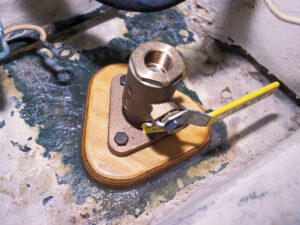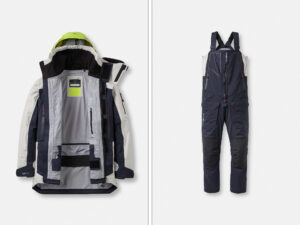While I love getting closer to nature while I’m cruising, there’s one part of the natural world that I emphatically want to keep its distance: insects. And especially so in my galley.
But the fact is that boats are pretty wide open, and many of the places in which we cruise don’t have the same standards of food sanitation that U.S. sailors may be used to. Add in warm, humid climates, and before you know it, it’s a battle of you versus the ants, weevils, and cockroaches.
The good news is that with an ounce or two of prevention, that battle is easily winnable. In six years of full-time cruising in Mexico and Central America aboard our Tayana 37, ¿Que Tal?, I never had a serious infestation. In fact, I actually had fewer bug problems than I’d had previously while living ashore on a small lake in Indiana.
The reasons? Constant attention to the possibility of a problem and a little time spent on prevention. By following these steps, you can help tip the odds in your favor of remaining free of onboard bugs.
1 – No cardboard on board: Some sources report that cockroaches lay eggs in cardboard; others say that isn’t so. But it doesn’t really matter: Dirt and bugs of all sorts can lurk in the cardboard. Make it a practice to dispose of as much cardboard as possible before bringing items on board. This is easy with packages having an inner liner, such as most cereals. For items without an inner liner, such as pasta, I immediately transfer the contents to a plastic storage container and toss the box onto the dock or into the dinghy. My rule is never to even set cardboard down on the boat.
2 – Wash produce immediately: When you bring produce on board, place it right in the sink and wash it immediately before putting it away. Pour a capful of bleach in 1 to 2 gallons of water, swish the produce around in the bleach water, then let it dry before putting it away. Start with the least dirty items; change the water when necessary. Not only does this get rid of bugs; it also helps you avoid food-borne illness.
3 – Wash cans: While you’ve got that bleach water, wash off the outside of any cans you just bought. I’m always amazed at how much dirt ends up in the water from cans that look perfectly clean. Before getting paper labels wet on cans of fruit and vegetables, be sure to label the tops using a permanent marker; this also makes it easier to find things in a top-loading locker. Aluminum cans washed with bleach water should be rinsed well to avoid pinholes caused by a reaction with the bleach water; be sure to dry such cans before putting them away.
4 -Treat flour right away: Begin by buying flour and box mixes only in stores that have high turnover because the longer that flour sits in the store, the more likely it is to have weevils. Bulk flour purchased from a bin should also be much more suspect, along with any food that locals don’t buy often and so sits on shelves. It’s easy to get excited about finding a box mix that you haven’t seen in months, snatching it up—only to discover that it’s full of nasties when you open it.
Methods commonly used by sailors to prevent weevils include freezing the flour or mix for 24 hours before putting it in a locker. You can often persuade a marina restaurant to let you put a few items in its freezer overnight. Alternatively, you can bake the flour or mix by spreading it on a pan and baking at 200 F for 30 minutes. Allow it to cool before putting it in a storage container along with some bay leaves, which also repel weevils; use two leaves for every 5 pounds of flour.
It’s best to store flour, sugar, and box mixes in sturdy plastic containers with very tight lids. Plastic bags frequently get tiny holes, which turn into open invitations for critters.
5 – Contain sugary stuff: If a bottle of honey or syrup leaks or breaks, ants will seemingly appear from the woodwork to get at it. Store bottles—both opened and unopened—of anything sugary in sealed plastic bins (the best choice) or in doubled resealable plastic bags. Not only will this keep ants away from any leaks; it will also make it much easier to clean up any leaks or broken bottles.
Store cans or bottles of fruit drinks, soft drinks, and beer in large plastic bins. This way, if you get a pinhole in a can, the mess is confined and much less likely to attract bugs.
6 – Repel ants with cloves: A whole clove or a sprinkling of ground cloves placed in every container of sugar will keep ants away. You can also use a drop of clove oil on the lid. Don’t worry—you won’t taste the cloves in your food. Use fresh cloves whenever you buy a new item.
7 – Immediately clean up spills: It’s not always convenient to clean up a mess in a locker or a storage bin when you find it. The unfortunate reality is that messes don’t clean themselves up, and once insects find a food source, they multiply rapidly. Five minutes of cleanup now can help you avoid hours—or days—of fighting an infestation later.
8 – Bugproof lockers: Put a few bay leaves and cloves (or sprinkle ground cloves or a few drops of clove oil) in every locker, and change them every three months. Also put a cockroach trap in each locker and change it at the recommended interval. I tried using an ant trap, but I found that the cloves were much more effective. I know that some cruisers use spray insecticides inside their lockers, but I strongly do not recommend using sprays around food—it’s simply too easy to get chemicals into the food.
If you can’t find roach traps, you can use a mixture of boric acid (usually available at pharmacies) and powdered coffee creamer or powdered milk mixed into a stiff paste. Fill the caps off soda or beer bottles with the paste and put them in your lockers; you can also smear a bit under the lip of the opening. While boric acid presents very low toxicity to adult humans (particularly in small doses), it should be kept away from children and pets due to their smaller size and propensity to put everything in their mouths.
9 – Promptly address any sign of bugs: The sooner you act, the easier it will be to get rid of bugs. If critters have gotten into any food, immediately throw it away—and by throw it away, I mean get it off the boat; don’t just place it in a trash bag on the boat. Check other containers in the same locker, too.
Scrub out any food containers, using a bleach solution of two or three capfuls per gallon of water for the final rinse. Wash out the affected lockers and any adjacent ones, also using a bleach solution. Let the containers and lockers dry completely before using them, since a moist environment attracts bugs. When you refill the containers or lockers, be sure to use the bay leaves, cloves, and cockroach traps as I described above. With these techniques, you can win this battle with the insects without resorting to that most drastic of solutions: the bug bomb.
Carolyn Shearlock spent six years cruising the waters off Mexico and Central America aboard ¿Que Tal? and now writes a blog about all things galley (www.theboatgalley.com). The Boat Galley Cookbook, which she wrote with Jan Irons, was published in September 2012.











